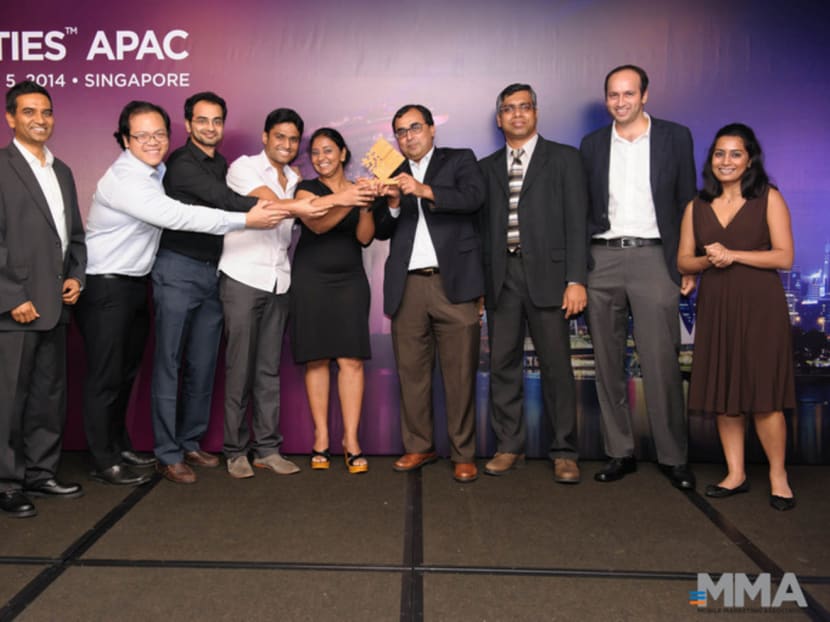Measuring mobile-app audiences
Advertisements are ubiquitous in our lives, from those in the morning newspaper to the ones in the bedtime reading on your tablet. The ad industry is a well-oiled machine, with billion-dollar firms such as Nielsen and comScore playing a key role by offering essential services such as audience measurement.

The Mobilewalla team last year received the Technology Company of the Year Award for APAC from the Mobile Marketing Association (MMA). Photo: MMA APAC
This commentary is part of a series in TODAY’s Science section, in collaboration with the National University of Singapore (NUS) School of Computing, that explores the computer science research projects conducted here.
Advertisements are ubiquitous in our lives, from those in the morning newspaper to the ones in the bedtime reading on your tablet. The ad industry is a well-oiled machine, with billion-dollar firms such as Nielsen and comScore playing a key role by offering essential services such as audience measurement.
Audience measurement tells advertisers the precise nature of the media audience, such as the fact that TV music competition The X Factor is watched by 70 per cent females and 30 per cent males.
It is a fundamental science that underpins advertising because companies want to promote their product on a media platform with audiences that correspond to the target users of their product. In many classes of media, for instance computer games, it is difficult for the advertiser to “guess” the exact nature of the audience.
However, a spanner has been thrown into the proverbial works with the advent of mobile smart devices and the rise of mobile apps: Existing methods of audience measurement are no longer applicable. There is widespread consensus regarding the attractiveness of the app medium to reach a large, diverse, global and engaged audience. As a result, mobile advertising in general, and in-app advertising in particular, is predicted to be the fastest-growing advertising sub-segment globally.
Notwithstanding this excitement, what has prevented brands from jumping onto the app medium is the lack of audience measurement for apps. Thus motivated, a group of scientists from the School of Computing at NUS, led by myself, decided to research this fast-moving field. Two years ago, we launched Mobilewalla, a media technology start-up venture.
We invented an entirely new class of big-data techniques to measure app audiences. With this method, we can find mobile applications that have a high likelihood of possessing similar audience characteristics.
We can also layer on a variety of publicly sourced data to estimate the characteristics of app users, across demographics such as age, gender, income and education. This data is derived from a variety of sources, including social media.
NEW WAYS TO UNDERSTAND YOUR AUDIENCE
Existing audience-measurement techniques rely on panels: small, carefully selected groups of individuals who act as the proxy for a population. This technique relies on the idea of “popularity persistence”, where people are expected to gravitate to a small set of popular items that will remain popular for significant lengths of time. This property ensures that the observed behaviour of a panel, for example, the fact that 80 per cent of a panel watch the same TV show, will be reflective of the behaviour of the population from which the panel was drawn.
However, it turns out that apps do not subscribe to these rules: An app ranked No 1 today could be out of the ranking charts in a week.
Apps effectively suffer from popularity transience, making audience measurement very difficult — panels cannot be used. As such, what we have done is tap into reviews written by app users, in native app stores. We gather these reviews and apply a well-known clustering technique known as collaborative filtering, which outputs a set of Affinity Apps — groups of apps that are likely to have the same audience profile. It is interesting to note that collaborative filtering is widely used in the industry for many popular consumer applications, such as the recommendations we receive on e-commerce portals such as Amazon.
In our case, the magnitude of input data — tens of terabytes — renders the application of standard collaborative filtering infeasible. As a result, we invented a variant of the algorithm and executed it on large clusters of cloud-based machines.
Powered by this audience data, we have launched a programmatic platform for serving mobile ads, which has become a favourite of a number of global agencies such as Mindshare and Joule.
Our techniques have attracted US$9 million (S$12 million) in venture capital from investors in the US and Asia. Last year, Mobilewalla won the Enabling Technology Company of the Year in Mobile award from the Mobile Marketing Association, a trade body for the mobile advertising industry.
While still early days, the traction that Mobilewalla’s innovations have received in the fast-growing mobile advertising ecosystem will inspire us to create even more technological advances to build the world’s most powerful mobile advertising platform.
ABOUT THE AUTHOR:
Anindya Datta is an associate professor of Information Systems at the NUS School of Computing. He is also chairman, co-founder and chief executive of Mobilewalla.





